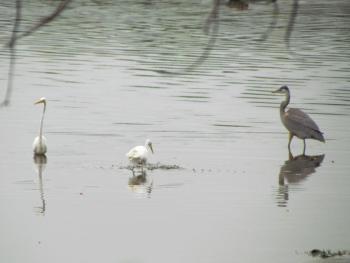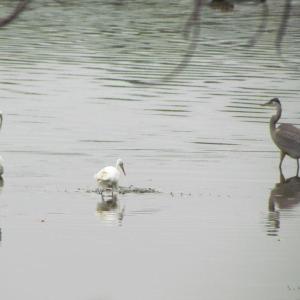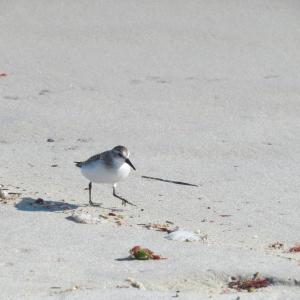Five Reasons to Love Birding in July
 July birding yields any number of surprises. The authors were delighted to spy this three-fer along the Kennebec River, where great blue herons can be readily seen but great egrets, less so. Courtesy of Jeff Wells
July birding yields any number of surprises. The authors were delighted to spy this three-fer along the Kennebec River, where great blue herons can be readily seen but great egrets, less so. Courtesy of Jeff Wells
 July is shorebird season. There's no better time to get out your binoculars and look for semipalmated sandpipers like this one the authors saw on the beach at Fortune's Rocks, Biddeford Pool. Courtesy of Jeff Wells
July is shorebird season. There's no better time to get out your binoculars and look for semipalmated sandpipers like this one the authors saw on the beach at Fortune's Rocks, Biddeford Pool. Courtesy of Jeff Wells
 July birding yields any number of surprises. The authors were delighted to spy this three-fer along the Kennebec River, where great blue herons can be readily seen but great egrets, less so. Courtesy of Jeff Wells
July birding yields any number of surprises. The authors were delighted to spy this three-fer along the Kennebec River, where great blue herons can be readily seen but great egrets, less so. Courtesy of Jeff Wells
 July is shorebird season. There's no better time to get out your binoculars and look for semipalmated sandpipers like this one the authors saw on the beach at Fortune's Rocks, Biddeford Pool. Courtesy of Jeff Wells
July is shorebird season. There's no better time to get out your binoculars and look for semipalmated sandpipers like this one the authors saw on the beach at Fortune's Rocks, Biddeford Pool. Courtesy of Jeff Wells
Some people think midsummer birding is boring.
Wow, are they wrong.
As we can personally attest, here's five reasons why you should go birding in July.
1) Odd Rarities: To paraphrase the great Forrest Gump, July is like a box of chocolates: you never know what you’re going to find! Just this week a fork-tailed flycatcher showed up at the Kennebunk Plains. A small flock (five juvenile) of white ibis appeared in York. A seaside sparrow made itself known in Scarborough Marsh. What’s next? You could be the one to make the next great rare bird discovery!
2) It’s Shorebird Season: Scan any area with mud flats, especially at half-tide (ideally with the tide coming in) and you're bound to see a smorgasbord of interesting shorebirds. Black-belled and semipalmated plovers. Semipalmated, least, and other sandpipers. Lesser and greater yellowlegs, short-billed dowitchers, the list goes on and on. Adult shorebirds are the first to begin returning south from their Arctic and Boreal breeding grounds, so many that you see in July will still have some remnants of the striking breeding plumage. Enjoy them while you can.
3) The Babies Have Arrived: Most young birds have fledged by July, and they're roaming around the woods, fields, and backyards. They may be challenging to identify, but that's the fun of it! Time to start looking at those supposedly “confusing fall warblers” that aren't necessarily as confusing as you may think.
4) Seabird State of Mind: Midsummer is when pelagic seabirds that migrate from the southern hemisphere visit the Gulf of Maine. They are escaping the cold, southern hemisphere’s winter by coming to the opposite side of Earth to be in our warm, northern summer. Grab your bins and hop on a whale watching boat—that’s another advantage to pelagic birding: You can enjoy the cooler offshore temps while scanning great shearwaters, Cory’s shearwaters, sooty shearwaters, and Wilson storm petrels—and maybe something even more unusual. For example, the famous tufted puffin has been roaming around several of the seabird nesting islands along the Maine coast. Keep your eyes open.
5) Wandering Waders: After the breeding season is over, egrets and some herons wander around, many coming north and some going inland. Great egrets, in particular, seem to show up in all sorts of little ponds and along riverbanks. Night-Herons and cattle egrets sometimes pop up, too. It’s kind of thrilling to see any of these striking birds appear unexpectedly in a place that you bird regularly. You won’t have another chance until next year!
Enjoy birding in July!
Jeffrey V. Wells, Ph.D., is a Fellow of the Cornell Lab of Ornithology and Vice President of Boreal Conservation for National Audubon. Dr. Wells is one of the nation's leading bird experts and conservation biologists. He is a coauthor of the seminal “Birds of Maine” book and author of the “Birder’s Conservation Handbook.” His grandfather, the late John Chase, was a columnist for the Boothbay Register for many years. Allison Childs Wells, formerly of the Cornell Lab of Ornithology, is a senior director at the Natural Resources Council of Maine, a nonprofit membership organization working statewide to protect the nature of Maine. Both are widely published natural history writers and are the authors of the popular books, “Maine’s Favorite Birds” (Down East Books) and “Birds of Aruba, Bonaire, and Curaçao: A Site and Field Guide,” (Cornell University Press).
























